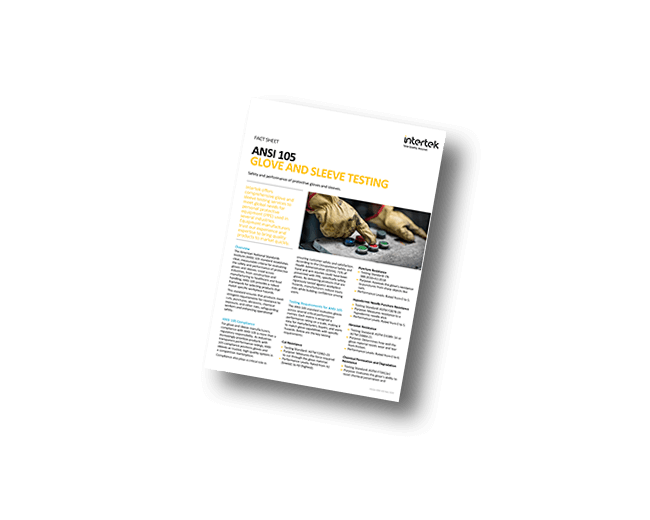ANSI/ISEA 105 Testing
Standard: ANSI/ISEA 105 – American National Standard for Hand Protection Classification
Certification Required: N/A
Scope: Per ANSI/ISEA 105: "This standard establishes performance specifications for protective gloves and other hand protection in relation to mechanical, chemical, and thermal hazards, ensuring workers' hands are safeguarded against a range of workplace risks."
Applicable Products: Protective gloves, including cut-resistant, abrasion-resistant, puncture-resistant, chemical-resistant, and thermal-resistant gloves.
Test Procedure:
Each glove is tested based on its designated protection category. Testing methods include:
- Cut Resistance: The glove material is subjected to a cutting test using a standardized blade under controlled conditions. Resistance is rated on a scale from A1 to A9.
- Abrasion Resistance: The glove material is rubbed against an abrasive surface until it breaks. Results are graded on a 0 to 6 scale.
- Puncture and Hypodermic Needle Resistance: The glove is penetrated by a pointed object under controlled force, and the resistance is measured in newtons.
- Chemical Permeation and Degradation: The glove material is exposed to specified chemicals to assess its degradation or breakthrough time.
- Thermal Resistance: The glove is tested for performance under extreme heat, cold, or flame conditions.
Technicians assess each glove for performance criteria and record results for each test category.
End Result: The tests yield performance classifications for each hazard category, helping manufacturers and end-users select gloves appropriate for specific risks and applications.
Special Notes: The ANSI/ISEA 105 standard is versatile and applies to a wide range of industries, including construction, manufacturing, healthcare, and oil and gas. Performance ratings for gloves are prominently displayed to aid in proper selection.
Intertek Testing Locations: Cortland, NY
This fact sheet outlines key testing metrics for gloves and sleeves to ANSI/ISEA 105, including resistance to cuts, punctures, abrasions, chemicals, heat, ignition and more.
Learn More – Visit our Knowledge Center
- Life Safety & Security Testing, Certification, and Compliance Solutions- fact sheet
- Alarm Service Certification Program - webinar
- ETL Certification Mark: Assurance of Compliance to National Standards - fact sheet
- Flame Detectors: FM 3260 Testing & Certification - fact sheet
- 10 Considerations for an Efficient Product Approval - fact sheet
- Becoming a Listed Alarm Service Company - white paper
- Overview of Product Certification - webinar
- Testing and Certification of Heat Alarms and Detectors - fact sheet
- Life Safety Security Testing and Certification Solutions - fact sheet
- Alarm Service Certification and Assurance
- Product Listing & Marking Strategies - white paper
- AHJ Handbook
- Becoming a Listed Central Station - white paper
Learn more about our ETL Mark
and certification from Intertek


